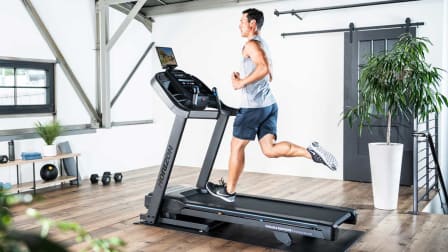How to Exercise at Home During the Coronavirus
Make your place your gym with CR’s expert guidance and try these three no-equipment-needed home workouts
When you shop through retailer links on our site, we may earn affiliate commissions. 100% of the fees we collect are used to support our nonprofit mission. Learn more.

For those of us who love the gym, the coronavirus pandemic has created a bit of separation anxiety.
Gyms across the country—my own included—have shut their physical doors, some under orders from officials and others as a preventative response to the virus. Many are turning instead to online classes as a way to keep their clients engaged and fit.
Planet Fitness, for instance, is offering a daily free class via Facebook Live and is promoting paid workouts through its app. Crunch Fitness notes on its website that it has more than 85 workouts on its "Crunch Live" streaming platform. Even small local gyms such as Alpha Interval Training in White Plains, N.Y., are extending services to online classes, nutrition guidance, and competitions, using social channels such as Facebook to keep members and their families engaged and working out.
Helpful Equipment for Small Spaces
You’ll want to try to get aerobic exercise, resistance training, and throw in some flexibility work, he says.
Anzalone notes that you can get a good aerobic workout with a jump rope. “Mix in different kinds of skips: single-footed, hopping from side to side, running, big jumps, double-unders, or swinging the rope in reverse,” he says.
You can run through bodyweight movements one after another and then break those into intervals that you time with your phone or a gadget like Gymboss. “Burpees, squat jumps, mountain climbers, sun salutations, walking lunges, or animal movements like ape, bear, crab, or dog will get your heart going,” Anzalone says. The key is to elevate your heart rate to a certain level and maintain that intensity.
Resistance training can be done with bodyweight exercises like the ones below, or as Anzalone notes, with a simple suspension trainer such as a TRX, which takes up very little room. Resistance bands can help make bodyweight moves harder or provide resistance for specific exercises like curls and triceps extensions. Some companies make dumbbells and kettlebells that you can easily adjust to change the weight so that you don’t have to buy multiple pieces, he says.
And you can get flexibility work done by stretching and self-massaging with a foam roller or even a lacrosse ball, he adds.
Plus, Anzalone says, remember that one of the greatest resources you have is the internet. A site such as ExRx will show you proper form, which is essential. And you can also try getting some moves in while you binge-watch your favorite shows.
How Online Training Works
Online training customized for you is another option to supplement your workouts—and can be a particularly good option if you’ve got limited space at home. Even before coronavirus, the popularity of online training was on the rise as offerings evolved from one-size-fits-all packages (some free, some paid) to more specific programs that take into account everything from where you exercise to whether you're training for a specific goal—such as an obstacle course race. Today there are plenty to choose from, and many allow clients to ask questions through email, an app, or phone calls.
I started using one of these plans about six years ago mostly because I wanted something tailored to my goals but that didn't require meeting up with a trainer at a certain time of day. Yes, I love the gym. But given the unpredictability of my schedule as the digital editorial director here at CR, a fixed commitment of that kind isn’t realistic.
My trainer is B.J. Ward, the head coach at Born Fitness, a firm that has created custom training and nutrition plans for clients for more than a decade. Ward, an Army veteran and now a trainer for 10 years, has a bachelor's degree in exercise science and is certified by the American College of Sports Medicine.
When the COVID-19 outbreak hit and it looked like many of us would be working from home for a while, I asked Ward to create some workouts for CR that would accomplish two things. One, be bodyweight-based so no equipment is required, and two, offer the ability to progress even over a long period of time.
"Your body does not need weights to change; it requires resistance," Ward says. "When machines, dumbbells, and barbells are not available (or you’re avoiding public places), your bodyweight can be used to create an amazingly effective workout."
He adds you just have to "create metabolic stress to compensate for a lack of overload" (e.g., adding weight as you get stronger). The way to do that is through circuits, one exercise after another.
In the workouts Ward created for CR, you’ll see circuits of six exercises that take a complete body approach, including the core. As you progress through the three different workouts, you’ll see the movements becoming harder and the reps increasing.
One quick note: Talk to your doctor before beginning a new exercise program. And proceed with caution, especially if you're new to working out. Remember, start slowly and stop immediately if you experience any pain.
3 Full-Body Workouts, No Equipment Needed
Instructions: Run through each exercise in the workouts below, which is one circuit, rest 1 to 2 minutes, and then do it again. Try to perform three rounds of the circuit and progress up to five. Watch the video to see the correct form for each exercise.
Do only as much as you can safely. In other words, you don't have to finish all reps or 30 seconds of the plank. And if you haven’t done pushups before, start on your knees.
Easy Workout
• Pushup to Down Dog: 10 reps
• Bodyweight Squat: 20 reps
• Bent Over Ys/Ts: 10 reps of each
• Reverse Lunge: 10 each leg
• Plank: 30 seconds
• Jumping Jacks: 5 reps
Moderate Workout
• Inchworm to Pushup: 10 reps
• Tempo Bodyweight Squats: 20 reps
• Iso Single Leg Deadlift Hold Ys/Ts: 10 reps each leg
• Tempo Sprinter Split Squat: 20 reps each side
• Slow Mountain Climbers: 10 each side
• Jumping Jacks: 25 reps
Intense Workout
• Pushup to Wall Press Hold: 10 reps
• Shrimp Squat: 10 each side
• Bodyweight Renegade Row: 20 each side
• Bodyweight Squat + 10-Second Hold at End: 25 reps
• Bear Crawl: 30 seconds
• Jumping Jacks: 25 reps




















